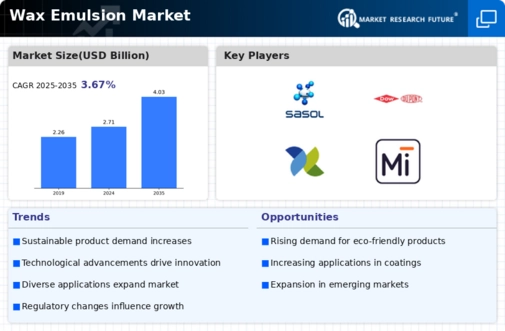Top Industry Leaders in the Wax Emulsion Market

Wax Emulsion Market
The wax emulsion market, a thriving segment within the broader chemicals landscape, is witnessing dynamic growth fueled by its versatility and adaptability across diverse industries. These emulsions, essentially suspensions of wax particles in water held together by emulsifiers, offer a plethora of functional benefits, making them a sought-after solution for applications ranging from cosmetics and coatings to textiles and agriculture.
Strategies Shaping the Wax Emulsion Arena:
-
Product Innovation: Leading players are constantly innovating, developing new wax emulsion formulations with enhanced performance characteristics and catering to specific industry needs. Sustainability is a key focus, with bio-based and readily biodegradable waxes gaining traction. For instance, BASF launched its Luwax® BE range, a line of bio-based polyethylene wax emulsions, catering to the growing demand for eco-friendly solutions. -
Geographic Expansion: Established players are expanding their global footprint, setting up production facilities in strategic locations to cater to regional demands and capitalize on emerging markets. Companies like Michelman and Dow Chemical are actively targeting high-growth regions like Asia-Pacific and Latin America. -
Vertical Integration: Some players are opting for vertical integration, acquiring raw material suppliers or downstream businesses to secure their supply chains and gain greater control over product quality and cost. This trend is particularly evident in the polyethylene wax emulsion segment. -
Partnerships and Collaborations: Strategic partnerships and collaborations are becoming increasingly common, enabling players to leverage each other's strengths and expertise in areas like research and development, distribution, and marketing. For instance, Lubrizol partnered with Croda International to develop and market a new range of wax emulsions for the personal care industry. -
Digitalization and Automation: Leading players are embracing digitalization and automation to optimize operations, enhance efficiency, and gain valuable market insights. This includes investing in advanced manufacturing technologies, data analytics platforms, and e-commerce solutions.
Factors Influencing Market Share:
-
Product Portfolio Breadth: Companies with a diverse range of wax emulsions catering to various applications and industries tend to hold a larger market share. -
Brand Recognition and Reputation: Established brands with a strong reputation for quality and reliability enjoy a competitive edge. -
Innovation and R&D Capabilities: Players with robust R&D capabilities and a consistent track record of innovation are more likely to gain market share. -
Production Capacity and Efficiency: Companies with efficient production facilities and ample capacity are well-positioned to meet market demands and secure contracts. -
Cost-Competitiveness and Pricing Strategies: Offering competitive prices and flexible pricing models can attract a wider customer base and drive market share growth.
Key Players
- BASF SE (Germany)
- Nippon Seiro Co.
- Altana AG (Germany)
- Sasol Limited (South Africa)
- DowDuPont (US)
- Exxon Mobil Corporation (US)
- Hexion (US)
- Michelman
- The Lubrizol Corporation (US)
- Danquinsa GmbH (Germany)
Recent Developments :
-
September 2023: BASF partners with a leading agricultural research institute to develop novel wax emulsion-based crop protection solutions. -
October 2023: Dow Chemical unveils a new bio-based wax emulsion for the personal care industry, targeting the growing demand for natural and sustainable cosmetics. -
November 2023: Atlanta AG acquires a wax emulsion production facility in China, strengthening its presence in the Asia-Pacific market. -
December 2023: Lubrizol and Danquinsa form a strategic alliance to jointly develop and market wax emulsions for the paper and packaging industry.

